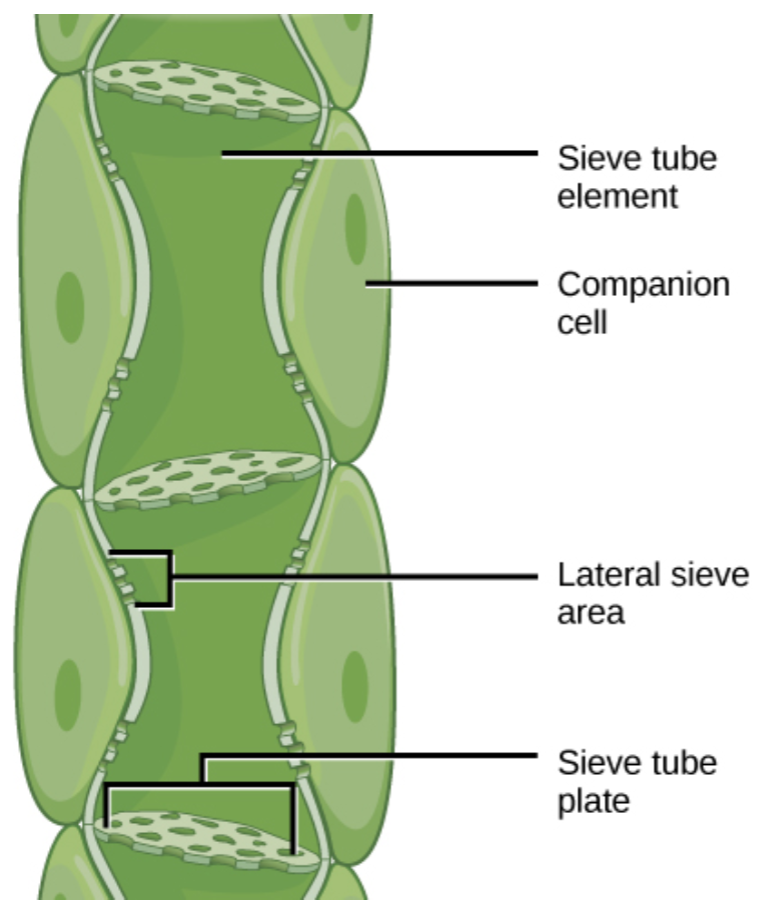
Sieve tubes are the constituent of
A) Wood
B) Vascular Cambium
C) Phellem
D) Bast
Answer
475.8k+ views
Hint: Sieve tubes are the perforated areas in the end walls which help in transport of food to the different parts of the plant. They do not have nuclei.
Complete Answer:
- Sieve tubes are the specialised cells which transport the food synthesised during photosynthesis. They originate at the meristem.
- Its major function is to transport sugars over large distances by acting as a channel.
- The porous cells help in establishing cytoplasmic connection between the neighbouring cells and thus result in movement to molecules. They lack nucleus but contain a few ribosomes. They are the major conducting cells in the phloem.

A) Vascular cambium- It is the major growth tissue in the stem and roots. It contains meristem cells.
B) Phellem- Phellem is also known as cork. It is composed of dead cells.
C) Wood- It is the structural tissue found in the roots and stem of the plants.
D) Bast- Phloem fibres are also called bast fibres. They are present in the inner bark and are fibrous in nature. Jute, flax, hemp etc are obtained from the fibrous phloem tissue.
Thus the correct answer is (D). Sieve tubes are constituent of bast or phloem.
Note: Sieve tube cells are elongated cells placed vertically with perforations. Sieve tube cells along with the companion cells play a major role in conduction of food in the plants.
Complete Answer:
- Sieve tubes are the specialised cells which transport the food synthesised during photosynthesis. They originate at the meristem.
- Its major function is to transport sugars over large distances by acting as a channel.
- The porous cells help in establishing cytoplasmic connection between the neighbouring cells and thus result in movement to molecules. They lack nucleus but contain a few ribosomes. They are the major conducting cells in the phloem.

A) Vascular cambium- It is the major growth tissue in the stem and roots. It contains meristem cells.
B) Phellem- Phellem is also known as cork. It is composed of dead cells.
C) Wood- It is the structural tissue found in the roots and stem of the plants.
D) Bast- Phloem fibres are also called bast fibres. They are present in the inner bark and are fibrous in nature. Jute, flax, hemp etc are obtained from the fibrous phloem tissue.
Thus the correct answer is (D). Sieve tubes are constituent of bast or phloem.
Note: Sieve tube cells are elongated cells placed vertically with perforations. Sieve tube cells along with the companion cells play a major role in conduction of food in the plants.
Recently Updated Pages
One difference between a Formal Letter and an informal class null english null

Can anyone list 10 advantages and disadvantages of friction

What are the Components of Financial System?

How do you arrange NH4 + BF3 H2O C2H2 in increasing class 11 chemistry CBSE

Is H mCT and q mCT the same thing If so which is more class 11 chemistry CBSE

What are the possible quantum number for the last outermost class 11 chemistry CBSE

Trending doubts
10 examples of friction in our daily life

Difference Between Prokaryotic Cells and Eukaryotic Cells

What is the specific heat capacity of ice water and class 11 physics CBSE

One Metric ton is equal to kg A 10000 B 1000 C 100 class 11 physics CBSE

State and prove Bernoullis theorem class 11 physics CBSE

State the laws of reflection of light




